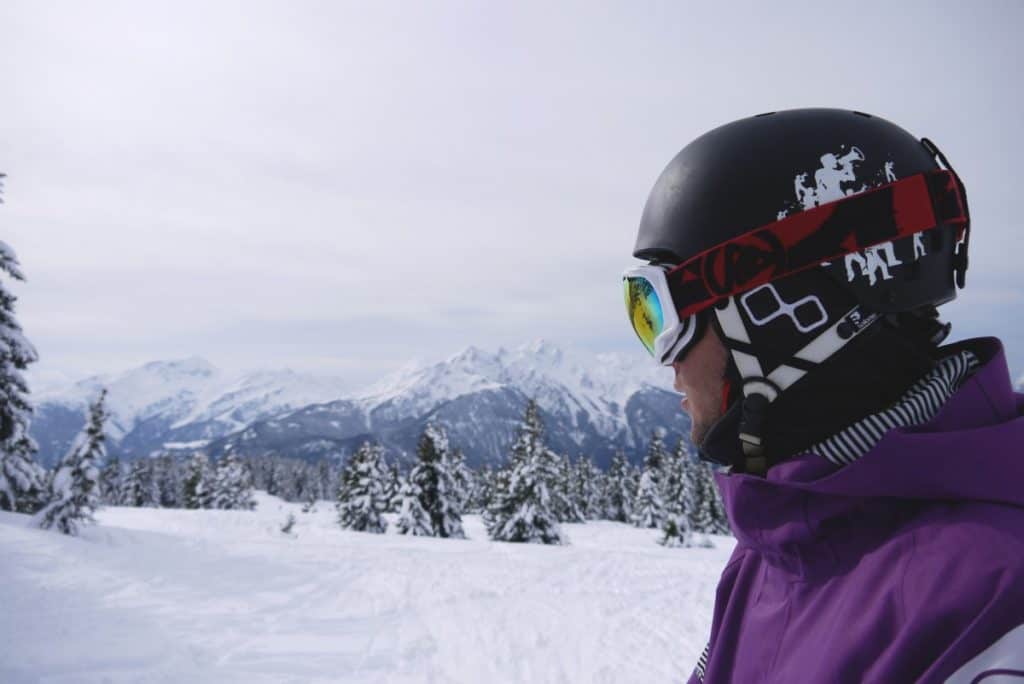Table of Contents
If you have just come back to the resort and you are still outraged by the fact that somehow your goggles will not do the one thing they should do, that is to keep your vision clear, calm down. We will help you prevent ski goggles from fogging. Here are the best and quickest solutions to the problem.
Goggles fog when the moist and hot air inside your goggles touches the cold lens of your goggles. You may have experienced your goggles fogging up and obscuring your vision when skiing, which is not just an inconvenience but may also blur out the surroundings which could lead to an accident.
How to Keep Ski Goggles from Fogging Up?
- If you want ultimately solve the problem, get a pair of anti-fog goggles, usually coming with a double layer lens. Check out the best one below and forget about this nerve-racking issue forever: Anon M4 Cylindrical Goggles
- Whatever goggles you have, it will always make things worse if you tuck your neck gaiter, face mask or balaclava under the goggles. Don’t do that!
- Don’t let snow inside the goggles! That’s a rule. If snow gets inside then you will have to change lenses or dry it thoroughly. The best option is a hand dryer at the nearest toilet.
- Again, always keep your goggles clean and dry! Do not use your hands or gloves to stroke the snow or dirt off. It will only get worse. Use the purpose-built dry cleaning cloth you received with the goggles.
- Keep your goggles ventilated. Either buy ventilated ski goggles, or take a moment to get your goggles off and let the humid air escape. On the other hand, if you otherwise get the goggles off, never put them over your forehead where your body would let the excess heat out.
If you want to know more, keep on reading! We will discuss the science behind fogging and the tips above in more detail.
- PERCEIVE Cloudy Pink spare lens, MFI face mask, microfiber goggle bag, and lens compression case included; Unisex frame design; Fits medium and large faces; Helmet compatible
- MAGNA-TECH uses magnets for quickly changing lenses and a secure lens-to-gram seal; PERCEIVE lens for high-contrast vision and terrain defining clarity; Coated for unmatched smudge, scratch, and moisture resistance; Lightweight, dual-molded PC-ABS/TPU frame improves lens interface performance and maintains a comfortable fit on the face …
Why are My Goggles Fogging Up?
When the internal moisture and hot air touches the extremely cold surface of your goggle’s lens, the humidity present in the air inside your goggles condenses to form water droplets.
If you want to prevent your goggles from fogging up, you need to first understand the reason why the fogging happens. The water droplets accumulate on your lenses making your vision blurry. Have you ever noticed that when you take a cold beer or water bottle out of the fridge/ freezer and put it outside, there are droplets all over the surface of the can or bottle? The exact case applies here when the warmer temperature and the extremely cold temperature react to form droplets from the moisture present in the air.
Once you understand what causes your goggles to fog up, the next step is to prevent or minimize the conditions that cause fogging. To do this:
- You must reduce the moisture inside the goggles as much as possible.
- Keep the temperature inside the goggles as close as possible to the temperature outside the goggles.
- Invest in anti-fog goggles with spherical lenses that give you a larger and clearer vision by sucking up a certain amount of moisture from the inside.
The temperature outside the goggles is freezing-cold. Although you need to keep your body warm in order to enjoy skiing and staying safe, you should not over-dress and over-heat your body because it will cause your body to sweat more. More internal body heat will only increase the amount of fog on your goggles.

5+1 Tips to Prevent Fogging Up
The accumulation of fog may be a natural way things work, but it is not like you cannot do anything about it! Keep the following factors in mind when you go skiing next time, and see the difference.
1. Open Goggle Vents
Not all goggles have air vents but most goggles of the mid-range do. Fogging is something that bothers a majority of skiers so most of the goggle manufacturers design goggles with a vent system to prevent fogging. Some of the top of the range goggles even come with built-in fans to prevent moisture from building up inside the goggles.
If your goggle vents are closed, your body temperature will cause the inside air to heat up. And with the vents closed, this warm air will have no outlet to escape from and it will condense on your lens.
If you are skiing down the slope and notice your goggles starting to fog up, check your goggle vents and make sure they are open.
If you are wearing goggles with a ski mask, the warm air when you breathe can rise to enter your goggles even when there is some separation barrier between the two. It is also important for your ski goggle to have ventilation when the mouth is covered. Normally face masks have an air hole or a mesh fabric to release your breath outside. Make sure your goggles are not taking in your exhaled warm breath from any place.
Another good idea is to lift off your goggles from your face when you are on the lifts. Lifts can be slow and with not getting enough wind for them to function, the vents may need a break for a couple of seconds. Lift your goggle to let some external air come inside to neutralize the difference between the internal and external air – do not prolong this exposure as a couple of seconds are all you need.
And while we are talking about vents, make sure your gloves do not have snow on them when you adjust your goggles. Be extra careful as you may not want to worsen your fogging issue by blocking the goggle vents from snow or moisture present on your gloves.
2. Don’t Stop Moving
Keeping your body moving is the best way to keep the air flowing and prevent the fog to accumulate on the lens. There are many goggles these days that come with a battery-powered fan to keep the inside dry and moisture-free. These vents let the cold air from outside come inside and throw the hot air inside outside.
Whether you are on a slow-moving lift or are waiting at the bottom of a hill for a friend if you stop moving you will notice a lot of nagging fog accumulating on your lens. Just take your goggles off for a minute to neutralize the temperature of the inside and outside of the goggle lens and put it back on. You do not have to remove it, just lift it up for a couple of seconds and then put it back in place making sure you did not accidentally put snow or wetness inside when you touch it.

3. Keep Your Goggles Dry
If your goggles are dry, there will not be much fog issues. So, keep the inside as dry as possible by minimizing snow, ice, or your sweat to cause fogging inside. If you feel you need to scratch your eyelids or readjust your goggles, make sure you do not do it with gloves that are damp or have some snow on them.
If you are one of those skiers who tend to over-dress themselves to avoid the cold weather, think again. If the day is extremely cold, you can put on some good layers of clothing but wrapping a neck warmer or a balaclava under your goggles to seal off your face from the cold could result in an increased production of warm and moist breath. If you are exhaling into something that has a direct route to your goggles, things are going to get pretty foggy throughout the day! To avoid this situation, you can keep your nose slightly exposed so you do not breathe inside the goggles and ideally leave a small separation between your balaclava and your ski goggles.
When you are doing skiing for the day, let your goggles dry naturally by putting them on a dry and airy counter. Some skiers even use hair dryers for this purpose, but it is better to let them dry naturally than to force warm air onto the lenses which could harm the surface in the long run.
4. Keep Your Goggles Clean
In case of a fall while skiing or if it gets snowing, the vents and padding of the goggles could get snow and hence moisture inside. As a result, you will experience a higher level of humidity inside your goggles and it becomes crucial for you to get rid of this moisture as soon as you possibly can.
The last thing you want would be to wipe the inside moisture with snowy gloves or moist fingers. Even if you wipe with a dry hand, the process of wiping could lead to the snow being pushed more inside the vents. The best way to deal with this situation is to tap your goggles against a hard surface so the accumulated snow could fall off.
If the goggle padding gets damp, the best (and only) way is to let it dry naturally. You may need a backup ski goggle for cases like these.
Even your goggles with anti-fog coatings when exposed to a fall or snowing condition may end up with moisture trapped inside them resulting in a foggy vision. No matter how tempting it may sound, the last thing you want is to clear this moisture with your gloves or fingers. Carrying a microfiber around for instances like these can be a good idea. The last thing you want is to scratch your lenses or wasting your time moving the snow and pushing water into the foamy padding.
5. Wear a Visor
As a skier, you may encounter the inconvenience of fogged up goggles from time to time, but not doing something about the fog making you go blind when you ski down the hill could become quite dangerous as well. And constant snowing can make things even harder.
Having a visor helmet is a great way to prevent your ski goggles from fogging up when it is snowing. The visor will be the protective layer on the top portion of your goggles keeping the moisture at bay.
If you are going to purchase a helmet with a visor, make sure there is enough room between the vents on top of the ski goggle and the visor. Do not block the goggle vents.

+1 Have a Spare
When the internal foam of your goggle gets wet, you can do nothing about it except to let it dry naturally. For this reason, the best way to enjoy a fog-free and stress-free ski trip is to keep interchangeable lenses or a spare goggle handy. You may or may not need this spare goggle, so you do not have to over-invest in it. It is better to ski with cheap dry goggles than with wet expensive ones!
Time to Upgrade: Anti-Fog Coating for Goggles
Your main ski goggle (not the backup one) is something that can be the deciding factor between enjoying your skiing trip and having a foggy experience all the way. Instead of going blind with fog with your goggles on and inviting accidents in snowy conditions, how about investing in a pair of anti-fog coated goggles?
While goggles with anti-fog coating may not function as well as intended if they get wet, they are far better than the other ones out there when it comes to fogging up. If you have already invested in your ski gear, upgrading your regular pair of goggles to anti-fog coated might be the thing you need to enjoy a crisp and clear view while skiing.
Conclusion
If you ever had a great day at the ski slopes dampened by a blurry vision from foggy goggles, you are not alone. Skiers often get frustrated by fogging goggle lenses. As they say, prevention is better than cure.
Check if your goggle has proper vents before making the final purchase. If you have not thought about it already, investing in a pair of anti-fog coatings for goggles is also a great way to upgrade not only your ski goggles, but also your skiing experience. Once you consider the above factors in mind, enjoy a fog-free skiing experience!






